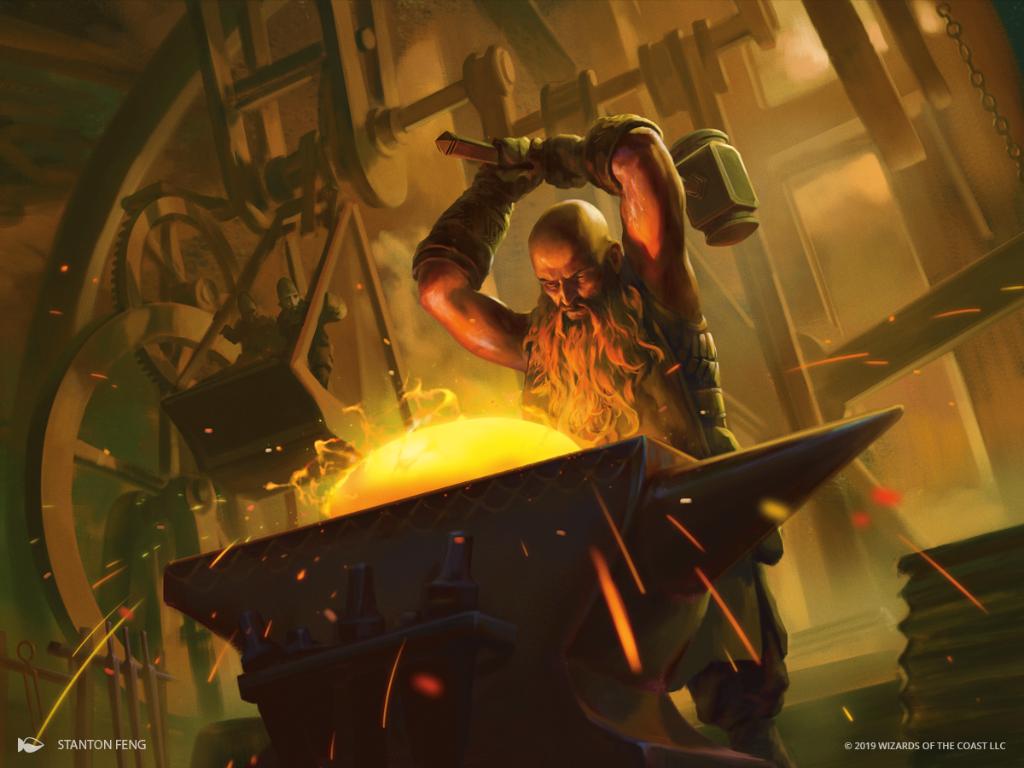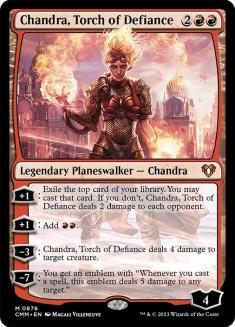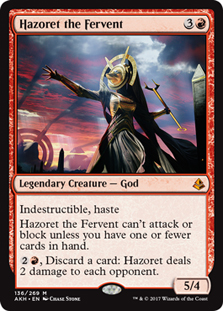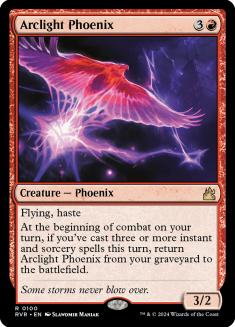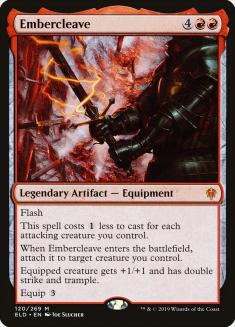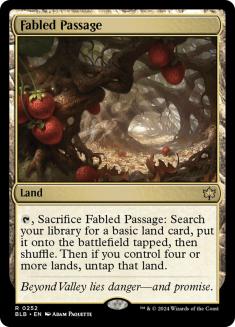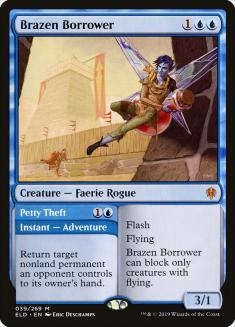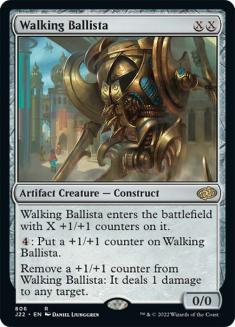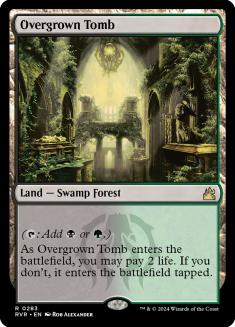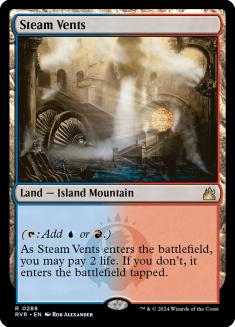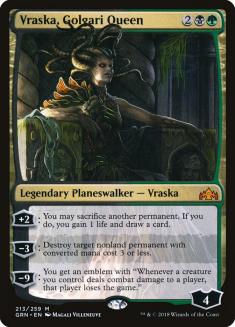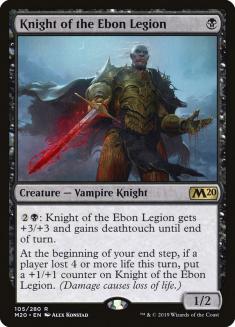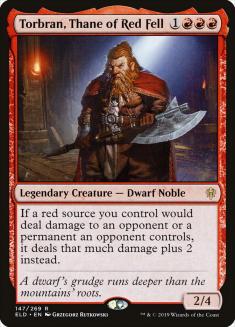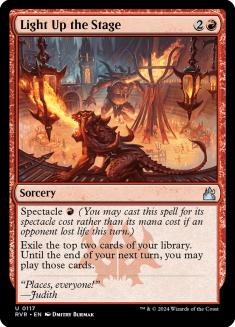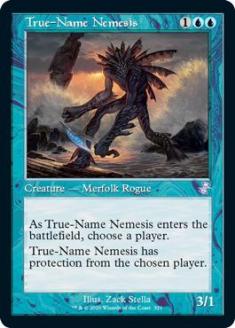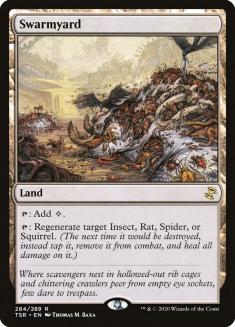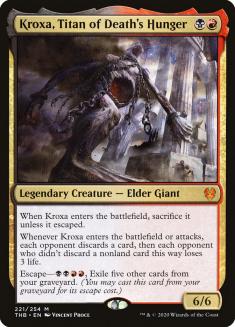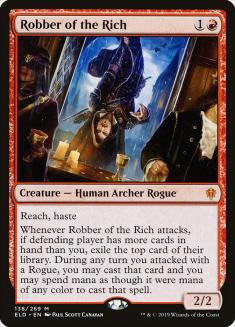We are now in the third year of Challenger Decks, and it’s tempting to shrug them off as old news. For the past couple of years, you could get away with scanning the decklists, taking note of the two or three key reprints that were likely to drop in price, and moving on with your day. Buying in might have made sense if you were a casual player, but most of us didn’t give it much thought.
In the world of Magic finance, the impact of these decks was a little harder to ignore. Even for us, though, the actual purchasing decisions were usually pretty simple. Every year seemed to have one deck that was well worth the MSRP (the one with Chandra and Hazoret in 2018, the one with Arclight Phoenix last year) and three that weren’t worth it. It made sense to pick up the good one and leave the rest behind, which resulted in a lot of big-box stores that had an unbalanced stack of mediocre Challenger Decks on their shelves.
The 2020 Challenger Decks are different, though. They are better. A lot better. So much better that we don’t only have to re-think our purchasing decisions surrounding these decks—we have to talk about how their impact on the Standard market could be both deep and long-lasting.
That’s why I want to spend the week detailing these decks in as much depth as possible. Should you be selling your reprinted staples now, more than a month before these decks hit shelves? How far are these cards likely to drop? And which decks are worth picking up once Star City Games starts pre-orders? Let’s find out.
How Far Did Previous Challenger Deck Staples Fall?
Before we get into the 2020 crop of Challenger Decks, I want to take a quick jaunt into the past. We now have two years’ worth of Challenger Deck data to analyze, giving us a good baseline estimate for of what to expect from the key 2020 staples as these decks enter the marketplace. Is there a clear pattern at work among the Challenger Decks’ most important reprints? That seems like something worth trying to figure out.
To that end, let’s take a look at the top ten cards from both the 2018 and 2019 Challenger Decks to see if there’s a pattern at work. While there’s no way to know exactly how much of this price movement is due to the existence of the Challenger Decks as opposed to shifts in the Standard metagame, I’m going to hope that we’ve got a large enough sample size to draw a meaningful conclusion regardless.
In an effort to provide the most consistent data possible, I’ll be using prices from the week before the Challenger Deck announcement as the “before” value, and prices from one month after their official release date as the “after” value. Let’s take a look:
2018 Challenger Decks
- Chandra, Torch of Defiance – $30 to $21
- Hazoret the Fervent – $24 to $15
- Walking Ballista – $12 to $24
- Fatal Push – $7 to $7
- Concealed Courtyard – $6.50 to $6
- Irrigated Farmland – $5 to $3
- Field of Ruin – $5 to $4
- Verdurous Gearhulk (x3) – $5 to $3
- Glint-Sleeve Siphoner (x4) – $4 to $1
- Unclaimed Territory (x3) – $4 to $2.50
Total – $102.50 to $86.50 – a 16% loss.
Interesting. A 16% drop seems incredibly low. I would have guessed we’d see a 30% drop at bare minimum, and I expected it to end up closer to 50% when all was said and done.
Why was the drop so minimal? Well, the biggest reason is easy to spot in the data set: Walking Ballista started seeing a lot more play after the Challenger Decks were announced but before they were released, causing the price to double instead of tailing off. If we remove Walking Ballista from our data set entirely, we end up with a 32% drop among the other nine cards—far closer to my initial estimate.
We’d have also seen a much greater drop if I’d calculated the value of these cards in late June instead of early May. The Standard market tends to be fairly robust in the spring, but it tails off quickly once summer begins. I didn’t want to extend our range out too far, though, because then I’d have to start comparing our reprinted cards with a control group of non-reprinted cards in order to compensate for seasonal trends and other metagame shifts. Our sample size of relevant reprinted cards is so small already that I’m not actually sure that would be any more useful than simply measuring these drops in a vacuum.
At any rate, let’s put a pin in this for now and take a look at the 2019 results.
2019 Challenger Decks
- Arclight Phoenix – $30 to $18
- Rekindling Phoenix – $20 to $11
- Sulfur Falls (x3) – $10 to $5
- Overgrown Tomb – $7 to $6
- History of Benalia (x2) – $8 to $5
- Jadelight Ranger (x2) – $5 to $2
- Legion’s Landing (x2) – $6 to $2.50
- Niv-Mizzet, Parun (x2) – $4 to $2
- Vraska, Relic Seeker – $4 to $3
- Goblin Chainwhirler – $4 to $1.50
Total – $98 to $56 – a 43% loss.
Here’s a result that’s much more in line with my expectations. There were no Walking Ballistas in 2019—instead, every card (save Overgrown Tomb and the already-cheap Vraska, Relic Seeker) saw a pretty significant drop in price. The cards that were reprinted in the greatest quantities did worst, but every card suffered. Even Arclight Phoenix, which was still seeing a lot of play in Modern, saw a pretty significant drop in value.
Have Any Previous Challenger Deck Reprints Managed to Rebound?
We know that the Challenger Deck reprints (mostly) dropped in price once the decks hit shelves, but did any of them manage to rebound later on, perhaps due to Modern or Pioneer demand? Let’s take a look at this same crop of twenty cards and see if we can find any that would have made good investments regardless.
Looking at the list of 2018 cards, Walking Ballista once again stands out as the biggest exception. The card is currently worth more than it was at any point in 2018, before or after being reprinted, and it seems to prove that it is possible for cards to spike after being printed in a Challenger Deck.
The pickings are slim beyond that, though. Chandra, Torch of Defiance is currently worth about as much as it was back in May of 2018, but it would have still been better to sell your copies as soon as the Challenger Deck was announced. The other eight cards simply kept dropping in price as set rotation approached, though a few did have minor rebounds once Pioneer was announced. None of them has even approached their post-Challenger Deck price tag, much less their pre-Challenger Deck price tag.
In 2019, there were no Walking Ballistas. The closes we’ve got is Overgrown Tomb, which didn’t really drop much after being reprinted and has recently been climbing in value. Overgrown Tomb currently sells for $13, which is almost twice as much as it was going for prior to being reprinted. Arclight Phoenix had the second-best performance, flirting with the $20-$25 mark a couple of times after being reprinted before eventually dropping down to its current $9 price tag. The other cards all followed a pretty similar trajectory to their 2018 brethren—dropping like a rock at set rotation before rebounding a little once Pioneer was announced.
Again, though, it’s unclear how much of these drops is a result of the Challenger Deck reprints as opposed to the fact that most cards tend to tank at set rotation simply due to how the Magic economy works. There’s no way of knowing what Arclight Phoenix would be worth now if it hadn’t been in a Challenger Deck, nor do we really know what would have happened if an expensive Pioneer staple like Thoughtseize were included in one of these decks.
Ultimately, I think all we can conclude from these results is that it isn’t impossible for cards from Challenger Decks to eventually rebound. The additional supply probably makes those rebounds both less likely and less lucrative, but figuring out those numbers isn’t going to be possible without a larger sample size to pull from.
Analyzing the 2020 Challenger Decks
Now that we’ve got a sense of what happened to the key cards from the 2018 and 2019 Challenger Decks, let’s take a look at our brand new crop of 2020 brews. Are they really that much better than last year’s entries? Let’s find out.
Allied Fires
Allied Fires is the Challenger Deck version of Jeskai Fires, a deck that’s still quite playable in the current metagame. While Allied Fires doesn’t include a lot of Jeskai Fires’s most important cards—Cavalier of Flame is nowhere to be found, for example—it’s still jam-packed with value.
$2-and-Up Cards
- Steam Vents – $15
- Ugin, the Ineffable – $5
- Kenrith, the Returned King – $5
- Temple of Epiphany – $4
- Narset, Parter of Veils (x4) – $3/each
- Temple of Enlightenment – $3
- Drawn from Dreams (x2) – $2.50/each
- Deafening Clarion (x2) – $2/each
- Fires of Invention (x4) – $2/each
- Temple of Triumph – $2
Total – $65
Allied Fires might not look too impressive, and it’s definitely the least exciting 2020 Challenger Deck, but a lot of these cards have higher-than-average price floors. The temples are likely to remain in the $2-$4 range as long as they’re Standard-legal, and Narset, Parter of Veils is likely to hold onto most of that $3 price tag due to the amount of play she sees in Commander as well as the eternal formats.
Most importantly, Steam Vents is the key reprint here, and it’s one of the most financially resilient cards in the history of the game. It might drop off a little over the short term, but I can’t imagine it’ll end up being worth less than $10 for long. Steam Vents is this year’s version of the Overgrown Tomb reprint last year, and that was the only key card from those decks that actually gained value from 2019 to today.
On the other side of things, this Challenger Deck is the end of the line for anyone who was hoping that Fires of Invention or Deafening Clarion would spike at some point. The lower-end cards from these Challenger Decks rarely end up rebounding, especially if they’re printed in super-high volume. I think Narset will prove an exception, but these other two will not.
Verdict: High floor, low ceiling. Worth buying if you need a Steam Vents and want to mess around with a very casual version of Jeskai Fires. Assuming these decks sell for approximately $30 each like they did the past two years, you’re basically paying full retail for a Steam Vents and $15 for the rest of this stuff. Seems like a fine deal to me.
Final Adventure
Final Adventure is a Golgari Sacrifice deck, complete with the super-fun Lucky Clover engine. This brew has fallen out of favor in the competitive metagame recently, but it’s still likely to have broad appeal to a casual audience. Is it worth buying, though? Let’s find out.
$2-and-Up Cards
- Fabled Passage – $20
- Vraska, Golgari Queen – $12
- Castle Locthwain (x2) – $8/each
- Knight of the Ebon Legion (x2) – $7/each
- Murderous Rider (x2) – $7/each
- Midnight Reaper (x2) – $3/each
- Temple of Malady (x2) – $2/each
Total – $86
Okay, yeah, this is why I feel confident in calling the 2020 Challenger Decks a game-changer. In each of the last two years, in both 2018 and 2019, there were only five cards printed across all four Challenger Decks that retailed for more than $5 prior to being reprinted. There are five such cards in Final Adventure alone. That is a pretty big shift.
As with Allied Fires, I expect the lands to be most resilient. Fabled Passage has an incredibly broad base of demand, and that demand will continue even after the card rotates out of Standard. The biggest wrinkle here is that Fabled Passage is actually in two of these Challenger Decks—more on that later—which means that it might ultimately end up losing more value than key 2018 and 2019 reprints like Chandra and Arclight Phoenix. The additional casual demand should mitigate that somewhat, but we’re still entering slightly new territory here, and I wouldn’t be shocked if Fabled Passage drops off quite a bit over the short-term.
Regardless, most of the lost value in Final Adventure will come from cards like Vraska, Golgari Queen; Knight of the Ebon Legion; and Murderous Rider. Vraska has already come down quite a bit, and that trend will only accelerate. The Knight sees play in Pioneer, but it’s expensive in large part due to the fact that it was printed in the relatively unpopular Core Set 2020. Murderous Rider should remain a $3-$4 card at least, but even that represents a 50% loss in value from its current retail price.
Verdict: Final Adventure is better than any of the 2018 or 2019 Challenger Decks. It will be hard for the combined staples in this one to ever total less than $30, and I imagine it’ll sell fairly quickly. The fact that the key card is Fabled Passage gives is a fairly high floor, too.
Cavalcade Charge
It’s time to look at Mono-Red Aggro, a deck that wasn’t all that present in the metagame when these decks were designed. Mono-Red is quite good now, though, and the aggressive red decks have been the best buys for two Challenger Deck seasons running. Will Cavalcade Charge break the pattern, or will it yet again become the best deck to buy?
$2-and-Up Cards
- Embercleave – $25
- Chandra, Acolyte of Flame (x3) – $6/each
- Bonecrusher Giant (x4) – $5/each
- Torbran, Thane of Red Fell (x4) – $5/each
- Light Up the Stage (x4) – $4/each
- Fervent Champion (x4) – $2.50/each
- Runaway Steam-Kin (x4) – $2/each
- Castle Embereth (x3) – $2/each
Total – $123
Wow. Somehow, the rather unassuming Cavalcade Charge deck is our best list yet. It certainly helps that we’re coming off a World Championship weekend where Mono-Red Aggro was the breakout deck of the event, causing several of these cards to spike over the past few days. Not only is Embercleave up to $25 now, but cards like Torbran, Light Up the Stage, and Fervent Champion are all sold out at current retail and had just begun ticking up.
From a speculation perspective, all of these $2-$5 cards are pretty close to becoming a sunk cost. The fact that Cavalcade Charge gives you four copies of almost every single staple, plus an Embercleave for good measure, means that the market is going to be absolutely flooded with these cards. Some of them might continue to kick around in the $2-$3 range for a while, but I’d be shocked if any of them ends up spiking toward the $10 mark at this point. This deck is just too chock-full of value.
As for Embercleave itself, that card is going to drop in price as well. If history is any indication, it’ll lose about $10 in value and settle in around the $15 mark. Regardless, Embercleave should still return about half of the retail price of the deck, making it a very solid buy.
Verdict: Cavalcade Charge is another home run. Embercleave is an even better pull than Fabled Passage, and the supporting cast in this deck looks stronger than the already-strong Final Adventure. Again, I find it hard to believe that this grouping of cards will retail for less than $30 total for very long.
Flash of Ferocity
Our last deck is Simic Flash, though it’s a version of the deck that gives us neither Oko, Thief of Crowns nor Uro, Titan of Nature’s Wrath. Are we about to get our fourth straight high-quality Challenger Deck, or is this where the party ends? Let’s take a look.
$2-and-Up Cards
- Brazen Borrower – $25
- Fabled Passage – $20
- Nightpack Ambusher (x4) – $5/each
- Shifting Ceratops (x3) – $5/each
- Castle Vantress (x2) – $4/each
- Mystical Dispute (x2) – $4/each
- Temple of Mystery (x2) – $3/each
- Thassa’s Intervention (x2) – $2/each
Total – $109
Flash of Ferocity doesn’t have quite as much overall value as Cavalcade Charge, but I bet it’ll end up being the most expensive deck in the collection by the start of summer. It’s the only 2020 Challenger Deck with two $20+ cards, Brazen Borrower and Fabled Passage, giving it a pretty big advantage over the field. $4-$5 cards can drop into the $1 range pretty easily, but high-value multi-format staples are always going to remain at least somewhat expensive. Nightpack Ambusher and Shifting Ceratops are about to lose more than half of their value, and this deck will still be worth well over $30.
Verdict: Flash of Ferocity is close to a must-buy if it’s available at or near the $30 mark. You should be able to get $30+ back for Brazen Borrower and Fabled Passage together, making these other cards pure profit. I also suspect that Brazen Borrower will be one of the few Challenger Deck cards to hold most of its value, since it sees so much play in so many formats.
Putting It All Together
All four of the 2020 Challenger Decks are better than their 2018 and 2019 counterparts. Not only do they contain way more midrange staples, but their high-end inclusions are a great deal better, too. Instead of only a few Standard cards being affected by these reprints, these decks contain some of the format’s most expensive staples.
While all three of these decks seem like no-brainer buys at $30, it’s worth remembering that there’s no MSRP for sealed Magic products anymore, and these haven’t popped up for pre-order yet. It’s possible that Wizards of the Coast (WotC) has increased the price of these decks while also making them more tantalizing. If we have to pay $40 each, the Jeskai Fires and Golgari Adventure brews start to look a lot less interesting. If we have to pay $50 each, then these prices might not drop much at all.
On the flip side, there’s no way that the contents of a print-to-order product can ever be worth too much more than that product’s retail cost. If you can just open a case of these and re-sell all the singles for a nice profit, than people will simply keep doing that until the values have evened out.
In previous years, both with Challenger Decks and Commander pre-cons, this process is somewhat bottlenecked by the fact that stores have to order these units in lots that contain all four decks. If one of them is worth cracking open and selling the singles and three of them are not, then the good one will disappear from shelves instantly while the other three sit around and linger for weeks. This keeps the stores from placing a ton of additional orders, which keeps the supply of the best deck nice and low, which is how you can end up with a card like True-Name Nemesis being worth more by itself than the deck it came in at the time.
All four 2020 Challenger Decks are good, though, and if they’re available at or near the $30 price point, they’ll sell through pretty quickly. Then it’s a matter of figuring out how well WotC managed to anticipate this sort of demand. Challenger Decks tend not to be among their best-selling products, and if they printed these at 2019 levels, it’s possible that they’ll always remain solid buys at retail. It’s also possible that WotC will churn these out at previously unforeseen levels, and prices will drop by 60-70% instead of 40-50%. And we probably won’t know which until after it’s too late to buy in.
This all tells me that the safest move is to sell out of these reprinted cards now. I certainly wouldn’t start tearing up my Standard decks or anything, but if you’ve got an extra Fabled Passage or Embercleave in your binder? It might be time to move on. Some of these cards might eventually end up being worth more than they are now, but if history is any guide, we’re looking at a loss of at least 30-40%.
If you’re in the market for any of these cards, especially the $5-$7 ones, just take note of what’s likely to happen to their price tags once these Challenger Decks are released. You probably won’t be able to hold off on buying them until then since these decks don’t hit shelves until April 3rd, but take note of the economics at play here. Whatever rotational losses you’re already expecting, double it for cards from these decks.
Lastly, if these decks do hit shelves at or near the $30 rate, consider picking up Cavalcade Charge and Flash of Ferocity right away. Worst case, they should hold their value—at least over a long enough time-frame. Best case, it’ll be an absolute steal, especially if you can trade most of the cards away before the prices catch up.
This Week’s Trends
WotC dropped some pretty big news on us this week, though we won’t know the full impact for a few more months. It’s Jumpstart, a brand-new product, and this year’s “innovation set” in the tradition of Modern Horizons, Conspiracy, and Battlebond. While Jumpstart looks like it’s aimed more at casual and new players than an experienced audience, the set will contain almost 500 reprinted cards as well as 37 brand-new Legacy-, Vintage-, and Commander-legal cards. It’s going to be a pretty impactful set from a Magic finance perspective, though probably not nearly as much as Modern Horizons was.
I don’t think there’s much we can do now to prepare for the release of Jumpstart, which is going to take place in early July. The set will definitely boost some prices based on the themes that are included, but I’d suggest against speculating on anything until we get a sense of what cards are going to be reprinted. With a roster of nearly 500 returning cards, I’ll be covering Jumpstart preview season in detail this summer in order to provide a list of cards that might spike when casual players look for the best additions to their brand new theme decks.
Speaking of casual spikes, Swarmyard had a pretty big surge this week and is somehow sold out at $20 retail. There are two possible reasons for this surge. First, Swarmyard meshes really nicely with the Year of the Rat Secret Lair drop, though it didn’t spike a few weeks back when the other good Rat cards started climbing. Second, you can play Swarmyard with the new legendary Squirrel from Unsanctioned. Silver-bordered cards might not be legal in Commander, but kitchen table players have a lot more buying power than most people realize. I’ve already seen the card start to dip back down a little, which tells me that at least some of the spike was buyout-related, but I still suspect it ends up stabilizing around $20 until its eventually reprinted.
Lastly, it was a pretty quiet week for movement in the competitive Magic sphere. Uro, Titan of Nature’s Wrath and Kroxa, Titan of Death’s Hunger are still both slowly trending up, but neither made significant enough gains to make me feel like either card is a must-buy at current retail.
The biggest gainer from World Championship XXVI, as I predicted, was Robber of the Rich. After spiking as high as $12 right after the event, it’s currently pretty stable in the $7-$8 range. You can definitely sell your copies now if you want, but there’s no rush. This card should remain in high demand for the next several months.

